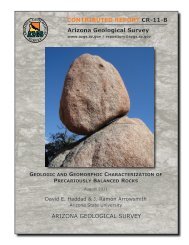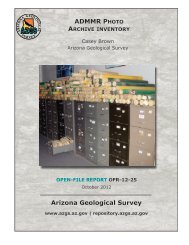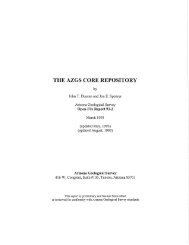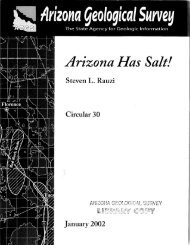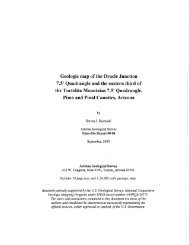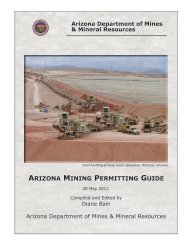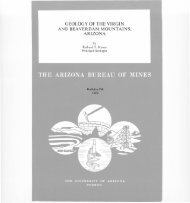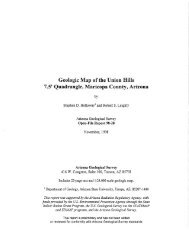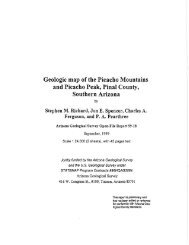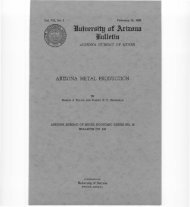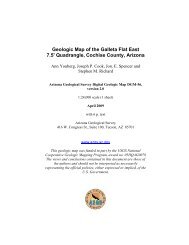Subsurface Geologic Investigation of Fountain Hills - AZGS ...
Subsurface Geologic Investigation of Fountain Hills - AZGS ...
Subsurface Geologic Investigation of Fountain Hills - AZGS ...
You also want an ePaper? Increase the reach of your titles
YUMPU automatically turns print PDFs into web optimized ePapers that Google loves.
time. The catalyst for inception <strong>of</strong> external drainage is uncertain. It likely involved<br />
incision or headward erosion across some bedrock dam at the south end <strong>of</strong> the basin.<br />
It is clear that deposits continued to fill the basin even after external drainage was<br />
established. Younger basin-fill deposits (map unit Tsy) appear to unconformably overlie<br />
map unit Tsm on the north side <strong>of</strong> <strong>Fountain</strong> Lake and farther north. Although map unit<br />
Tsm may represent axial river deposits contemporaneous with map unit Tsy, the<br />
significant relief between the two units exposed on the north side <strong>of</strong> <strong>Fountain</strong> Lake<br />
argues against this idea. It is the younger basin-fill deposits (map unit Tsy) that underlie<br />
the Town <strong>of</strong> <strong>Fountain</strong> <strong>Hills</strong> and indeed much <strong>of</strong> the Lower Verde River Valley. Although<br />
these deposits do not exist in the northwest part <strong>of</strong> the basin they probably at one time<br />
existed there and have since been stripped away by erosion.<br />
BASIN STRUCTURE<br />
Faults<br />
Several fault systems exposed in the bedrock surrounding the basin all show<br />
similar curved geometries, concave to the northeast (see figure 1). The Sugarloaf Fault on<br />
the east side <strong>of</strong> the basin is a down-to-the-east normal fault down-dropping basalt and<br />
conglomerate against granite. Differential thickness <strong>of</strong> units on opposite sides <strong>of</strong> the fault<br />
show that faulting initiated during deposition <strong>of</strong> the Miocene conglomerate and continued<br />
on into the Quaternary (Skotnicki and Leighty, 1998; Pearthree et al., 1995)<br />
The Horseshoe Dam Fault has the same geometry as the Sugarloaf Fault and cuts<br />
even older volcanic and sedimentary rocks <strong>of</strong> the Chalk Canyon Formation. This fault has<br />
also been active as recently as Late Pleistocene (Piety and Anderson, 1991). The<br />
Horseshoe Fault is well defined in the Horseshoe Basin but where it curves to the<br />
southeast, near Bartlett Lake, it is defined by a series <strong>of</strong> parallel, curving, and possibly<br />
discontinuous fault strands. These parallel fault strands cut through granite that slopes<br />
northeastward toward the Verde River. A well-formed, south-sloping pediment is<br />
beheaded by the crest <strong>of</strong> the northeast-facing slope, suggesting beheading may have been<br />
related to rapid erosion caused by relatively recent movement along the parallel fault<br />
strands.<br />
8



